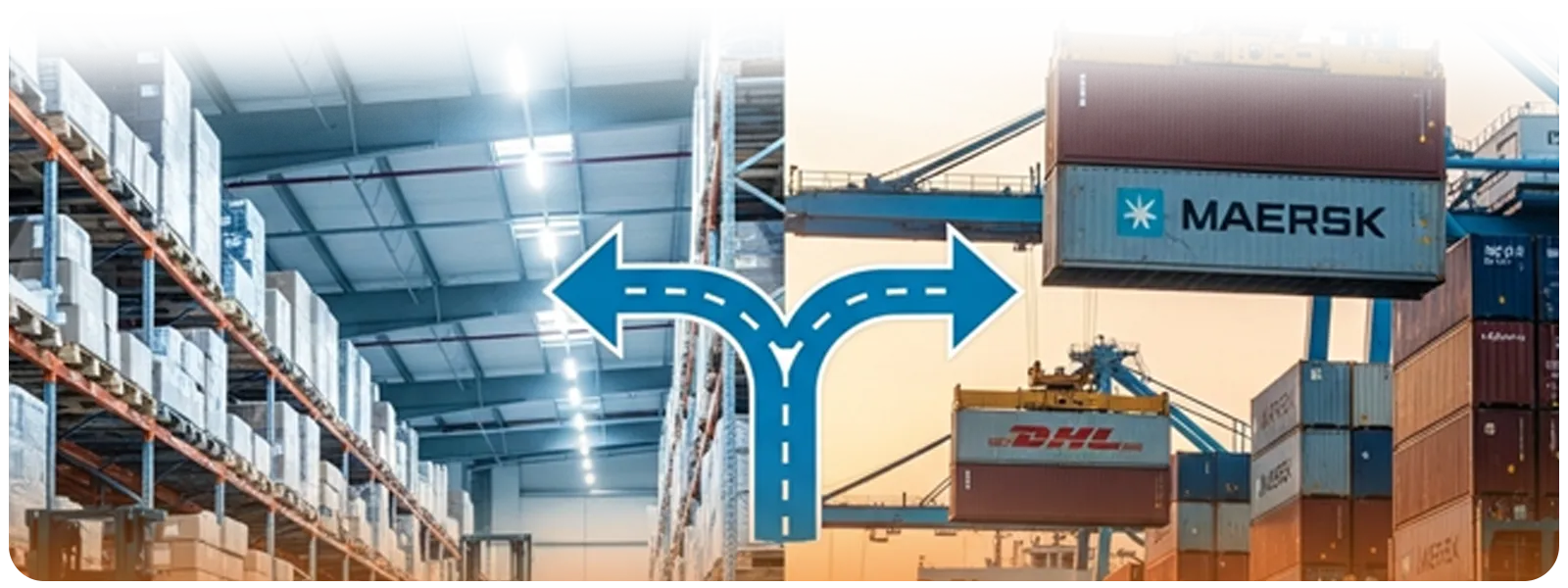
In-House vs. Outsourced 3PL Operations: Which Saves More in 2025?
In 2025, logistics leaders face a sharper choice: run operations in-house or partner with a 3PL. Rising costs, volatile demand, and shifting trade rules mean the decision is no longer about who’s cheaper, it’s about resilience, risk, and speed to scale, as highlighted in the CSCMP 2025 State of Logistics Report.
In-house offers control but demands heavy fixed investment. Outsourcing provides agility but adds relationship risk.
The Strategic Dilemma – Control vs. Agility

The decision isn’t about which is “better.” It’s about matching the model to your company’s growth strategy, risk tolerance, and competitive priorities.
In-House = Control
- Direct oversight of service quality and processes.
- Ideal integration with manufacturing, sales, and strong customer and carrier relations ensures consistency across the entire operation..
- Greater ability to enforce brand standards.
Control comes with weight. Warehouses, fleets, and salaried staff are expensive commitments.
When demand dips, those assets don’t scale down, cost per unit spikes, eating into margins.
Outsourced Logistics= Agility
- Variable cost structure instead of heavy fixed assets.
- Ability to scale up for peak seasons or new market launches.
- Access to advanced systems and logistics expertise without upfront investment, a trend reflected in the outsourcing-to-insourcing relocation shift.
The risk: reliance on a partner. Service failures, hidden fees, or high switching costs can erode flexibility over time.
Costs That Matter in 2025

To compare in-house with outsourcing, companies need to consider the Total Cost of Ownership (TCO) for in-house operations and the Total Cost of Relationship (TCR) for 3PL partnerships. TCO, widely used in logistics analysis, captures the full lifecycle cost of assets, while TCR frameworks account for relationship and switching costs unique to outsourcing.
In-House Costs Include:
- Capital investments in facilities, fleets, and technology.
- Fixed overhead like management salaries, property taxes, and insurance.
- Variable expenses such as labor, fuel, maintenance, and utilities.
- Hidden drains like underused assets, inefficiencies, or downtime.
3PL Costs Include:
- Service fees for warehousing, transportation, and add-ons.
- Relationship management costs for oversight and integration.
- One-time onboarding expenses such as IT setup and training.
- Risk exposure from switching providers or service failures.
In-house ties up capital but avoids dependency, while 3PLs reduce upfront investment yet introduce ongoing relationship risk. The right lens is the total cost, not the sticker price.
Stress-Testing Each Model

Forecasts rarely play out as planned. The smarter move is to test how each model performs under different conditions.
1. Demand Swings
- In-house: High fixed costs hurt in a downturn - assets sit idle, but bills keep coming.
- 3PL: Costs flex with volume, making downturns less painful and growth easier to absorb.
2. Input Cost Shocks
- In-house: Fuel spikes or rising labor rates hit directly, often adding pressure to claims and risk management teams who must absorb the financial and operational fallout.
- 3PL: Large providers may soften impacts by spreading costs across clients and leveraging buying power.
3. Break-Even Point
- At what volume does in-house become cheaper than outsourcing? If your business consistently stays above that threshold, control pays off. If not, 3PLs usually win.
Scenario testing reframes the question. It’s less “Which is cheaper today?” and more “Which model keeps costs predictable when things change?”
Strategic Factors That Tip the Scale
Even the best financial model doesn’t capture everything. Leaders also need to weigh the strategic value each option brings.
Operational Control
- In-house: Direct authority over processes, staff, and human resources. Essential if logistics touches brand-critical moments.
- 3PL: Less oversight, but stronger access to advanced systems and proven best practices.
Scalability
- In-house: Capacity is fixed. Expanding means heavy investment and long timelines.
- 3PL: Rapid scale up or down, making it easier to enter new markets or handle seasonal peaks.
Focus on Core Strengths
- In-house: Management attention is pulled into running logistics.
- 3PL: Frees capital and leadership time to focus on innovation, growth, and customer relationships.
Risk Profile
- In-house: Asset utilization risk in downturns.
- 3PL: Dependency on a partner and high switching costs.
Takeaway: Neither path is risk-free. The choice hinges on whether control or agility is more valuable to your long-term strategy.
The Decision Framework: Finding Your Fit
Choosing between in-house and 3PL isn’t about a universal answer. It’s about matching the model to your company’s priorities.
A simple scoring framework helps bring clarity.
Key Criteria to Weigh:
- Total Cost: Which option delivers cost predictability without locking in unnecessary administrative and financial overhead?
- Scalability & Agility: How fast do you need to flex capacity or enter new markets?
- Operational Control: How mission-critical is logistics to your customer experience?
- Risk Exposure: Which model carries risks your business can realistically manage?
Example Decision Matrix
- Stable, cost-driven businesses may weight Total Cost highest.
- High-growth companies entering new markets may weight Scalability most.
- Premium brands with sensitive delivery needs may emphasize Control.
Your decision framework should be weighted to your strategy, not to generic industry averages. The “right” model is the one aligned with how you plan to compete and grow.
Strategic Recommendations: Two Clear Paths

Once the decision is made, success depends on execution. Each path demands a different playbook.
If You Choose In-House:
- Invest in technology: Modern WMS and TMS platforms are non-negotiable for efficiency and visibility.
- Build process excellence: Lean and Six Sigma methods help reduce waste and errors.
- Develop talent: Competitive pay, training, and safety programs keep skilled staff engaged.
If You Choose a 3PL:
- Select rigorously: Go beyond quotes, evaluate tech capabilities, industry expertise, and cultural fit. Site visits and due diligence are critical steps, as highlighted in research on logistics outsourcing practices.
- Lock in strong SLAs: Define KPIs around accuracy, on-time performance, and inventory visibility. Tie them to clear rewards and penalties.
- Govern actively: Don’t “set and forget.” Hold regular reviews and strategic check-ins to keep the partnership aligned.
The decision is only step one. Long-term success depends on disciplined investment, governance, and alignment with company strategy.
The 2025 Logistics Call
The logistics question for 2025 isn’t simply “in-house or outsource?”, it’s which model strengthens your resilience, predictability, and growth path.
In-house delivers unmatched control but ties up capital and locks in fixed costs. A 3PL adds agility and expertise but introduces dependency and relationship risk.
The smartest move is to test both models against your company’s realities, demand swings, expansion plans, and customer promises and choose the path that aligns with strategy, not short-term cost savings.
Done right, logistics stops being a back-office function and becomes a competitive advantage.
Our experts at FreightBridge BPO help logistics leaders design flexible, cost-smart operations that match growth priorities.
Book Your Free Strategy Call Today and discover how the right model can power your next stage of growth.


